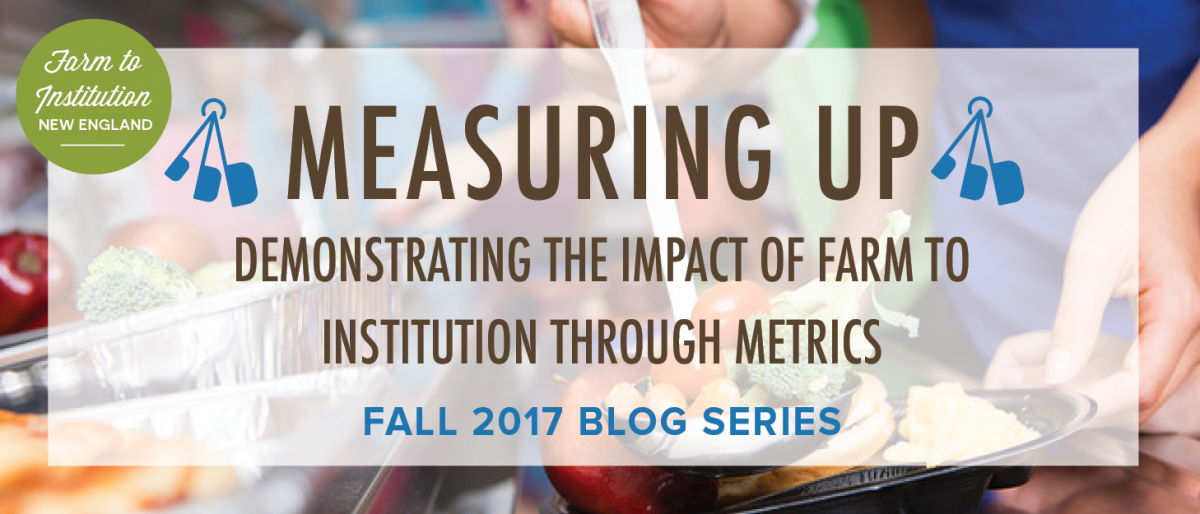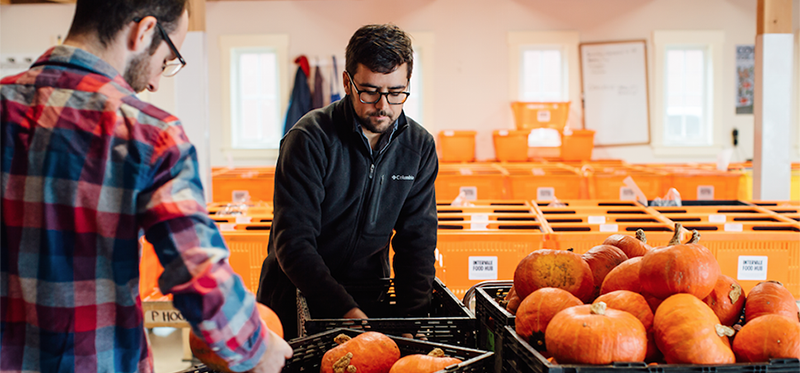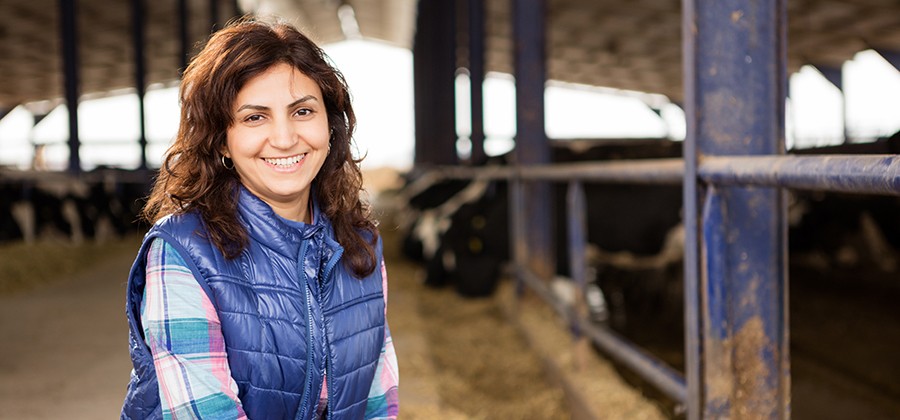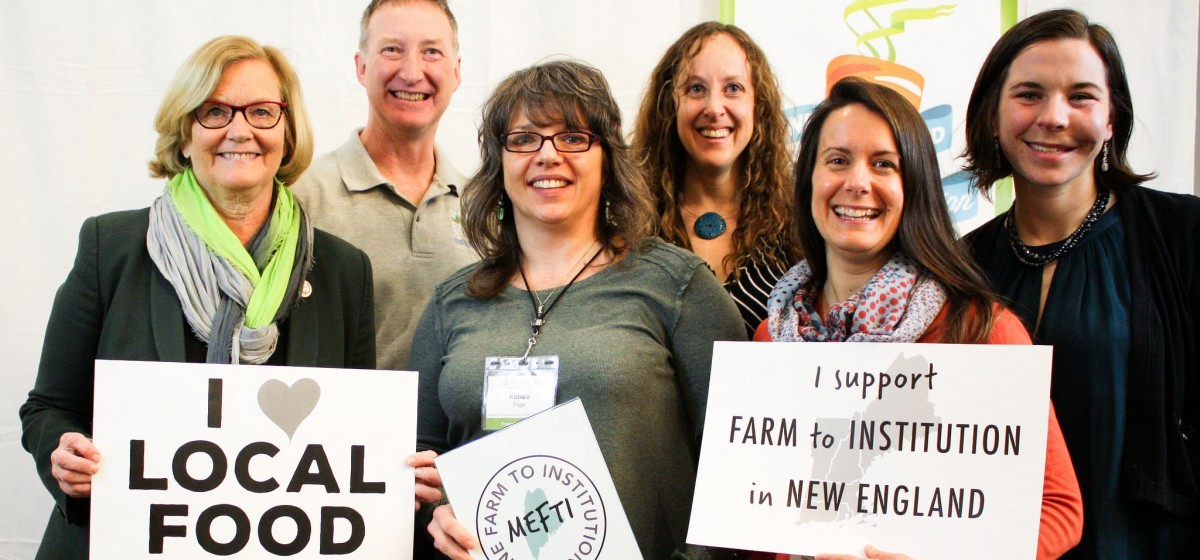
This installment was originally posted on the Farm to Institution New England (FINE) blog.

INSTALLMENT NO. 6 OF 6
The Power of Institutions to Change the Food System
New England schools, hospitals, and institutions of higher education serve approximately 3.8 million people every day and spend hundreds of millions of dollars on food and beverage each year. Increasingly, these institutions are shifting their purchasing habits towards buying more local and regional food, a choice that can have significant effects on local communities and economies. Because of their enormous purchasing power, institutions have the opportunity to catalyze major food system shifts by redirecting even a small percentage of their budgets toward locally produced goods.
These shifts are reflected economically, environmentally, and socially. USDA estimates that with a local food multiplier effect between 0.4 and 1.6, K-12 schools alone have the opportunity to trigger over $1 billion of local economic activity by investing in local food.
FINE’s 2016 Producer Perspectives survey showed that producers who currently sell to institutions grew by an average of three acres over three years, while those that didn’t sell directly to institutions stayed the same size. In New England, where just 5% of the land is dedicated to food production, opportunities to increase farmland allow the region to depend less on industrial agriculture production and move towards self-reliance. Establishing local relationships with farmers, fishermen, and ranchers also allows for increased levels of transparency and accountability which can lead to more sustainable and responsible production habits.
Further, institutions provide meals to thousands of financially-distressed people in the region. In New England, almost 12% of the population is food insecure, a term defined by USDA as a “household-level economic and social condition of limited or uncertain access to adequate food.” For many of the 1.7 million New Englanders who don’t know where their next meal will come from, schools, hospitals, and institutions of higher education can provide consistent access to fresh and healthy food.
Data-Driven Recommendations for Achieving Success
FINE is dedicated to making an impact all along the farm to institution supply chain by educating core stakeholders about what they can do to move this critical work forward. Our key recommendations for institutions, food distributors, and food producers, as well as our data-based advice for government staff and elected officials, funders and nonprofits, and producer service providers including extension agents, are summarized below (more detailed information is also available in our three research reports).
Recommendations for Institutions
Recommendations for the institutional sector revolve around incorporating local and sustainable language, goals, and definitions into existing or upcoming contracts, requests for proposal (RFPs), and purchasing agreements. FINE also recommends that institutions have a clear definition “local” and invest in setting up and consistently using reliable tracking tools so these purchases can be measured over time. FINE’s Food Service Toolkit provides guidelines on how to negotiate contracts with food service management companies and suppliers to emphasize local food procurement; Farm Commons also offers this guide to writing a basic sales agreement.
In 2014, the USDA farm to school program produced a series of 12 webinars on local procurement for school districts. The webinars provide guidelines for conducting a baseline procurement assessment, working with local producers and distributors, and understanding how to use contracts and informal procurement methods to increase local purchases. While the webinars are designed for K-12 schools, much of the information is relevant to other types of institutions as well. Finally, FINE’s suite of case studies provides farm to institution success stories from New England institutions.

Photo courtesy of the Intervale Food Hub in Vermont
Recommendations for Distributors & Other Intermediaries
Distributors of all sizes can invest in local tracking tools and marketing systems that provide institutions with a clear sense of where a product is coming from. Distributors serve as important mid-tier value chain actors and can provide producers with information regarding the needs of institutions like packaging, invoicing, shipping, and certifications. Establishing buying commitments, whether year round or seasonal, will also help ensure a market for producers and a consistent supply for institutions. Formal procurement commitments include RFPs and invitations for bid (IFBs) which require a public solicitation for products. Distributors/vendors are awarded contracts based primarily on price if other stipulations are met.
Increasingly, institutions are including language in their RFPs that emphasizes a geographical preference. By responding to these RFPs and meeting institutional demand for local products, distributors are helping to tilt the scale towards making local the new norm. Distributors can also help initiate non-public contracts between producer and institution that are determined by qualifiers other than price. Forward contracts are one type of agreement that takes place between producer and purchaser ahead of the growing season and locks both parties into a certain price and quantity of product. These contracts ensure a market for producers and a consistent product for institutions; they also often include flexibility clauses that allow for unavoidable circumstances.
As institutional demand for local product increases, so does the need for alternative aggregation and distribution services that can address the unique challenges of working with local food. Food hubs, commercial kitchens, and co-packing services provide processing services like peeling, cutting, emulsification, and cooking; pickling, pasteurization, freezing; and packaging. For institutions that do not have the capacity to process large quantities of raw product, these services allow those institutions to purchase local food without sacrificing convenience.
Packaging and preservation services also enable the use of local products throughout the year which we know is a major challenge for institutions interested in working with local foods. The New England Food Processor’s Community of Practice (CoP) provides a forum for these New England organizations to share best practices and develop solutions to common problems. There are currently six members of the CoP that provide services to food businesses, farms, distributors, schools, colleges, hospitals, restaurants, retailers, and other supply chain players. Producers, institutions, and processing facilities interested in learning more or engaging with these organizations can reach out to peter@farmtoinstitution.org.
Recommendations for Producers
FINE recommends that producers interested in institutional markets attend wholesale readiness trainings and “meet the buyer” meetings. These events provide an opportunity to better understand what is required of institutional markets. Producers can also reach out to specific institutions directly to see what types of local products they have a hard time finding and consider working those into their crop plans. Marketing arrangements and purchasing agreements are a valuable way to ensure a consistent market and fair prices.
Working with other producers in the community to aggregate products can also be an effective way to streamline the delivery process. Institutions often do not have the capacity to receive several small deliveries and are more likely to work with small and mid-size producers if they can access the volume they need through the most streamlined delivery system possible. Aggregating product and delivering it as one large order also allows individual producers to spend less time delivering the product and more time on the farm. Smaller distribution companies, processors, and food hubs provide similar aggregation services and often work more closely with local and regional products than larger companies.
FINE’s New England Local Processor’s brochure provides information on some of these businesses.
Recommendations for Nonprofits, Cooperative Extension Agents, and Funders
Stakeholders along the supply chain, including nonprofits and producer service providers, can support farm to institution efforts by funding, hosting, and otherwise supporting wholesale readiness workshops and institutional market preparation trainings. “Meet the buyer” meetings can bring institutional purchasers and producers together to discuss needs, prices, and ways to develop more sustainable working relationships. When providing these services, facilitators are encouraged to keep in mind the busy seasonal schedules of farmers and producers in New England and to schedule events accordingly.
Funders and grantmakers can help enable technical assistance for institutions who are working to incorporate more local purchasing into their contracts and agreements with producers, distributors, and food service management companies. Funders can also provide assistance to smaller distributors who are interested in working with institutions to find ways that they can successfully connect with these markets. Support for additional research on the economic impact of farm to institution is also needed.
Recommendations for Public Policy Decision-Makers, Government Officials, and Advocates
The FINE team believes that implementing appropriate state policy that either mandates or allows for the preferential purchasing of local food at the institutional level can have a major impact. Procurement policies can manifest in a variety of ways and many states have implemented successful farm to institution policy already. Requiring or allowing institutions to spend a certain percentage of their food and beverage budget on local food is one example; this type of support takes campaigns like the Real Food Campus Commitment and makes them mandatory.
In Illinois for example, the 2009 Local Food, Farms, and Jobs Act set a goal that 20% of all food and food product purchased by stated agencies and state-owned facilities would be local by 2020. To fulfill this goal, the state established the Local Food, Farms, and Jobs Council which provides technical assistance to farmers, aids state agencies with tracking and reporting, and works to build infrastructure for aggregation, processing, storage, packaging, and distribution of local products. Under the Local Food, Farms, and Jobs Act, all state agencies who purchase food are required to identify a baseline of local purchases and then track and report local farm or food products purchased annually.
A similar law, the Farm to Table Act, was passed in Missouri in 2017 and requires participating institutions to purchase 10% of their food products locally by December 31, 2019. The act created a position for a state farm to institution coordinator and requires the department of health and senior services, the department of elementary and secondary education, the office of administration, and the department of corrections to provide support for farm to institution programming.
Another example of procurement policy requires institutions to purchase locally if the price of local food product falls within a certain percentage of the price of non-local product. This type of legislation exists in Massachusetts where state agencies are required to purchase agricultural products grown in the state so long as the price is within 10% of the price of product grown outside of the state. Introducing policy based on price preference pushes institutions to purchase locally while recognizing realistic budget restrictions; in order for these policies to have an impact, meaningful awareness and enforcement strategies need to be implemented as well. Other recommended public policy initiatives include incentivizing the use of local distributors and processors, and incorporating farm to institution language into state food plans and state policy councils.
Extensive resources dedicated to food and procurement policy at the state, regional, and local levels can be found through the Johns Hopkins Center for a Livable Future’s Food Policy Network. Its resource database offers over 1,000 reports, guides, and strategic plans for all levels of government and its Food Policy Council Map includes a state-by-state look at the specific work Food Policy Council groups are doing across the country.
The Harvard Food and Law Policy Clinic also offers legal and policy resources related to procurement including its “Tools for Advocates: Increasing Local Food Procurement by State Agencies, Colleges, and Universities.” Newer food policy resources include the Healthy Food Policy Project and the State Farm to School Legislative Survey, both of which provide searchable databases of policy related to local food in institutions. FINE is currently building a policy working group and determining how to best serve New England institutions at the policy level.
Dive Deeper
FINE’s three recent research reports include expanded findings and recommendations that have been explored in this blog series. You can download these reports – and much more – on our New England Farm to Institution Metrics Dashboard.
Farm to Institution New England
FINE is built on the idea that farm to institution is critically important to transforming the regional food system and that success is dependent on cross-sector collaboration. Our work is to understand, support, and connect existing industry members, organizations, state networks, and key stakeholder groups across New England and across the supply chain.
By 2030, we envision New England institutions and the FINE network playing leadership roles in cultivating a region that is moving measurably toward self-reliance. FINE’s vision is in alignment with those of many other food system entities, including the New England Food Vision created by Food Solutions New England.
We envision an equitable and just food system that provides access to healthy and abundant food for all New Englanders, and is defined by sustainable and productive land and ocean ecosystems. FINE stands ready to help key stakeholders better understand and use the results of the metrics project to further this work in the region.
If you have any questions or want to learn more about FINE’s metrics work, please contact hannahr@farmtoinstitution.org or nessa@farmtoinstitution.org.
Want to get connected and support farm to institution efforts? Visit our website at www.farmtoinstitution.org for the latest news and resources or sign up to receive our e-newsletter, The FINE Print, at www.farmtoinstitution.org/newsletter. You can also follow us on Facebook, Twitter, LinkedIn, Pinterest, Flickr, and YouTube.
Hannah Leighton is a Research Associate with Farm to Institution New England working with the metrics team.








